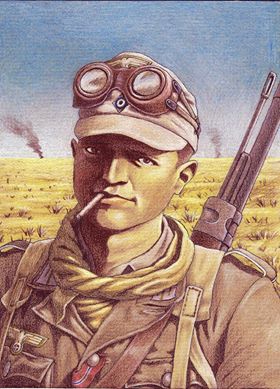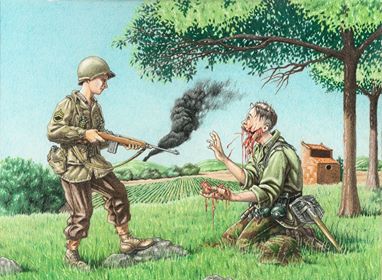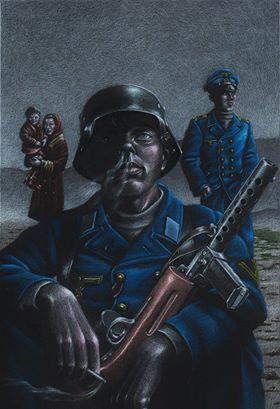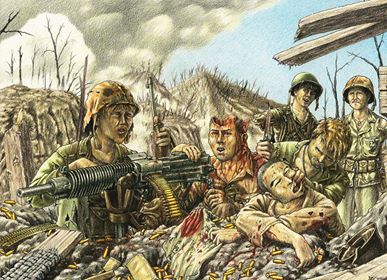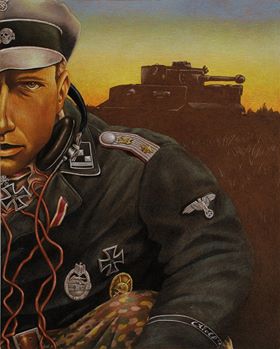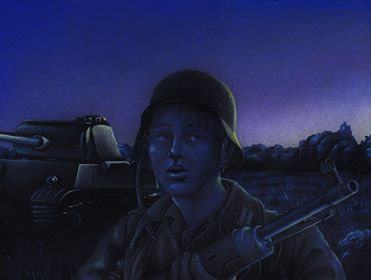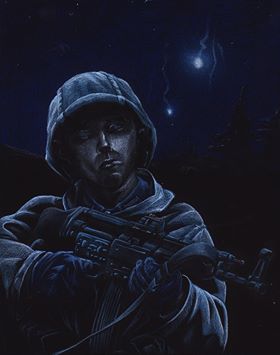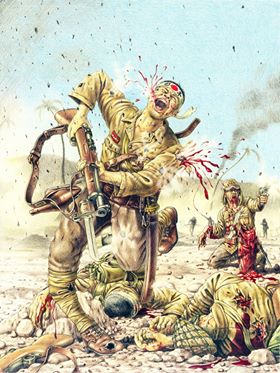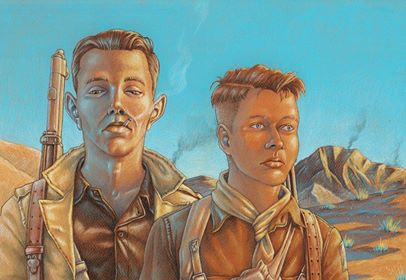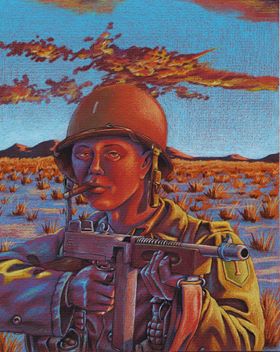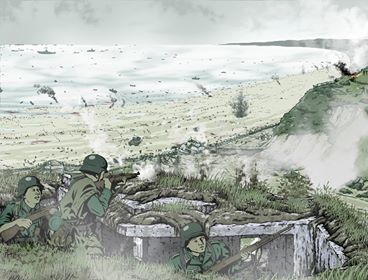
Blog
The Second World War resulted in the deaths of around 85 million people. Additionally, tens of millions more people were displaced. However, amid all the carnage, people demonstrated remarkable courage, fortitude, compassion, mercy and sacrifice. We want to honour and celebrate all of those people. In the War Years Blog, we examine the extraordinary experiences of individual service personnel. We also review military history books, events, and museums. We also look at the history of unique World War II artefacts, medals, and anything else of interest.
From Battlefields to Boardrooms: How World War II Tactics Can Revolutionise Your Business Strategy
In our latest article, we delve into the contrasting tactics used by the British and German armies during WWII and extract practical advice for today’s business leaders. Discover how the British Army’s centralised command structure often led to slower response times and missed opportunities, and learn how you can avoid these pitfalls in your own organisation.
A Light Tank Mk.VIA of the 3rd King's Own Hussars. By British Army photographer. - This photograph ARMY TRAINING comes from the collections of the Imperial War Museums (collection no. 4700-101), Public Domain, https://commons.wikimedia.org/w/index.php?curid=2113928
In the high-stakes arena of modern business, leaders are constantly seeking innovative ways to stay ahead of the competition. Surprisingly, some of the most valuable lessons in organisational agility and decision-making can be drawn from an unexpected source: Second World War military tactics. In this article, we will briefly explore the contrasting tactics used by the British and German armies in WWII and provide some practical advice for today's business leaders.
The British Approach: Centralised Command and Its Pitfalls
During World War II, the British and German armies employed starkly different tactical approaches, which had significant impacts on their battlefield effectiveness. The British Army, particularly its infantry, often found itself at a disadvantage due to its rigid command structure. This system was characterised by centralised decision-making, strict adherence to hierarchy, and limited autonomy for lower-ranking officers and soldiers.
As a result, British units frequently had to await orders from higher up the chain of command before adapting to new situations. This led to slower response times, missed opportunities, and loss of initiative on the battlefield. The inflexibility of the British system often left them struggling to keep pace with rapidly changing circumstances.
The German Strategy: Auftragstaktik and Decentralised Decision-Making
In contrast, the German army embraced a philosophy known as “Auftragstaktik” or mission-type tactics. Decentralised decision-making and empowerment of junior officers and non-commissioned officers marked this approach. It allowed for greater flexibility to adapt to changing battlefield conditions.
The German approach fostered initiative and adaptability at all levels, enabling their forces to react quickly to evolving threats and exploit unexpected weaknesses. This agility gave them a significant advantage in maintaining a high level of operational tempo and seizing opportunities as they arose.
StuG´s of the SS-Kampfgruppe “Harzer” of the 9th SS-Panzer-Division “Hohenstaufen” during the battle of Arnhem, Operation Market Garden 1944.
In Aaron Bates’ book, The Last German Victory (2021) he highlights the stark contrast between German and British military tactics during the ill-fated Operation Market Garden of September 1944. The German army’s doctrine emphasised individual initiative and aggression, allowing their forces to quickly adapt and respond to unexpected situations. This approach, coupled with their reliance on self-contained infantry units with substantial organic firepower, provided a significant tactical advantage. In contrast, the British Army’s strategy was heavily dependent on indirect firepower (artillery) and rigid planning, which proved less effective in the fast-paced, airborne assault environment of Market Garden. Bates argues that these doctrinal differences were pivotal in shaping the battle’s outcome, displaying the Germans’ ability to leverage their strengths against the Allies’ more rigid and less adaptable tactics.
StuG´s of the SS-Kampfgruppe “Harzer” of the 9th SS-Panzer-Division “Hohenstaufen” with British prisoners during the battle of Arnhem, Operation Market Garden 1944.
Translating Military Tactics to Business Strategy
The historical example of these contrasting military tactics holds valuable lessons for today's business leaders. Companies that allow employees to make decisions within the framework of overall organisational goals are likely to be more agile and responsive to market changes. Encouraging initiative at all levels can lead to innovation and improved problem-solving.
A decentralised approach can significantly reduce the time it takes to react to new challenges or opportunities. In a fast-paced business environment, the ability to quickly adapt to changing circumstances is crucial for success. While maintaining strategic oversight is important, creating a culture of empowerment allows for better tactical execution.
Implementing Mission-Type Tactics in the Corporate World
Clear Communication of Goals
To apply these lessons in a business context, leaders should focus on clear communication of goals. It is essential that all employees understand the company’s overall mission and objectives. This shared understanding provides a framework within which individuals can make decisions confidently.
Trust and Empowerment
Trusting and empowering employees is crucial. Micromanaging employees can stifle creativity, erode trust, and lead to decreased productivity and job satisfaction, ultimately resulting in higher turnover rates and a toxic work environment. Give team members the authority to make decisions within their areas of responsibility. This trust fosters a sense of ownership and accountability, often leading to more innovative solutions and improved performance.
Encouraging Calculated Risk-Taking
Creating an environment where reasonable risks are accepted and learned from is also important. Encourage calculated risk-taking and view failures as learning opportunities rather than reasons for punishment. This approach can drive innovation and help the organisation stay ahead of competitors.
Lessons from British Army Evolution: Investing in Training and Equipment
The importance of comprehensive training and proper equipment is starkly illustrated by the British Army’s experience in World War II. In the early years of the war, British forces often found themselves at a disadvantage due to inadequate training and outdated equipment. This deficiency contributed to several setbacks and defeats, particularly in the North African campaign.
British infantry training on an assault course, 1941. Photograph from the archive of the Imperial War Museum (H 12699)
However, the British military, political and industrial leadership recognised these shortcomings and acted. From 1941 onwards, there was a concerted effort to improve both training regimens and equipment quality. This included more realistic combat training (battle school), better integration of arms, and the introduction of more effective weapons and vehicles. The results of these improvements became evident in later campaigns, with British forces showing increased effectiveness and adaptability on the battlefield.
This historical example offers valuable lessons for modern businesses. Like the British Army of the early 1940s, many organisations today may find themselves ill-equipped to face rapidly changing market conditions. The solution lies in a commitment to ongoing training and investment in the right tools.
In a business context, comprehensive training should focus on developing both hard and soft skills. This includes technical training specific to job roles, as well as leadership development, decision-making workshops, and scenario-based exercises that simulate real-world challenges. By exposing employees to a wide range of potential situations, companies can build a workforce that’s adaptable and confident in their ability to handle unexpected circumstances.
Equally important is equipping employees with the right tools for the job. Just as the British Army needed modern tanks and aircraft to compete effectively, today’s businesses need cutting-edge software applications and technology. From project management tools that facilitate collaboration to data analytics platforms that enable informed decision-making, the right software can significantly enhance an employee’s ability to work autonomously and effectively.
Moreover, investing in user-friendly and efficient systems reduces friction in daily operations, allowing employees to focus on higher-level tasks rather than getting bogged down by cumbersome processes. This not only improves productivity but also boosts morale as employees feel the company is invested in their success. Without a doubt, cutting corners on equipment can produce the opposite result, causing bottlenecks in the workflow, decreased productivity, more mistakes, and unhappy employees.
The combination of comprehensive training and the right equipment pays off in increased confidence and competence across the organisation. When team members feel well-equipped, both in terms of skills and tools, they are more likely to take initiative, make informed decisions, and contribute meaningfully to the company’s success. This empowerment aligns perfectly with the principles of mission-type tactics, fostering a workforce that can adapt quickly to changing circumstances and seize opportunities as they arise.
Furthermore, this investment sends a clear message that the organisation values its employees and is committed to their growth and success. This can lead to improved job satisfaction, higher retention rates, and a more positive company culture overall.
By learning from the British Army’s evolution during World War II, modern businesses can understand the critical importance of continually updating their training methods and tools. In doing so, they can transform their workforce from one that struggles with outdated practices to one that excels in the face of new challenges.
Promoting Open Communication
Promoting open communication is essential for a decentralised approach to work effectively. Encourage the free flow of information across all levels of the organisation. This transparency helps ensure that decisions are made with the best available information and that lessons learned are quickly disseminated.
The Power of Decentralisation in Modern Business
By adopting a more decentralised approach, like the German military’s mission-type tactics, businesses can foster innovation, improve response times, and better adapt to the fast-paced, ever-changing modern business environment. This does not mean abandoning strategic oversight, but rather creating a culture where employees at all levels feel empowered to act in the best interests of the company’s mission.
Lessons from the Past, Strategies for the Future
In the words of General George S. Patton, “Never tell people how to do things. Tell them what to do and they will surprise you with their ingenuity.” By embracing this philosophy, modern businesses can unlock their full potential and outmanoeuvre their competitors in the complex battlefield of the global marketplace.
The lessons from World War II tactics remind us that in both warfare and business, adaptability and empowerment at all levels can be the key to success. As we navigate the uncertainties of the modern business world, it is time to look to the past for inspiration on how to build more resilient, agile, and successful organisations for the future.
Contact us today to discover the ways military history can inform and benefit business strategy, tactics, leadership, communication, motivation, and training.
References:
Dupuy, T. N. (1977). A Genius for War: The German Army and General Staff, 1807-1945. Prentice Hall.
Bates, Aaron (2021). The Last German Victory, Operation Market Garden 1944. Pen & Sword Military.
Van Creveld, M. (1985). Command in War. Harvard University Press.
Note: This article is for educational purposes only. The author acknowledges that while historical examples can provide valuable insights, modern business practices should always be adapted to current ethical standards and legal requirements.
D-Day 75th Anniversary Commemoration
As part of the D-Day 75th-anniversary commemorations, The War Years will be adding a range of content over the coming week.
As part of the D-Day 75th-anniversary commemorations, The War Years will be adding a range of content over the coming week.
The Story of D-Day, Part One
The Plan
The largest amphibious operation in military history, code-named Overlord, D-Day started in the early hours of 6 June 1944. The objective was an 80 km stretch of the Normandy coastline. An armada of 7000 ships planned to land 175,000 men, 50,000 vehicles and all their equipment by day’s end. 11,000 aircraft, oil pipelines under the English Channel and even giant Mulberry Harbours would be towed across the sea.
Neptune
Operation Neptune was the naval element of the Overlord plan. 7,000 vessels from battleships to landing craft, Neptune was truly an allied effort. British, American, Canadian, French, Norwegian, Dutch, Polish and Greek vessels all played a part in enabling the landing’s success.
The Landings
The Allies planned to land on 5 beaches code-named Utah, Omaha, Gold, Juno and Sword. The flanks or sides of the planned beachhead would be secured by airborne forces dropped during the night and early morning on 5/6 June.
Pegasus Bridge
Strategically important, the bridges over the Caen Canal and Orne River had to be captured to enable Allied tanks to operate east of the river, and prevent German counter-attacks against the landings.
Seized by a daring glider assault the bridges were successfully captured by Major John Howard’s D Company, 2nd Battalion, Ox and Bucks Light Infantry at just after midnight, 6 June 1944. Once captured it was vital Major Howard’s men held the bridges against counter-attacks until relieved by Lord Lovat’s 1st Special Service Brigade at 1 pm.
Merville
In the area immediately east of Sword Beach, some 4,800 elite airborne troops landed by parachute and glider. Men of the 9th Parachute Battalion took the German coastal battery at Merville that threatened the British landing beaches.
US Paratroops
The American 82nd and 101st Airborne Divisions secured the flanks of the US beaches. However, the 6,600 men dropped were badly scattered that reducing their initial effectiveness, although this did confuse the German defenders. The paratroopers successfully secured the exits from Utah Beach and captured bridges en route to Carentan.
The Story of D-Day, part Two
The American Beaches
Utah Beach
The D-Day landings started at the low water mark on a rising tide at 06.30hrs in the US sector and 07.30hrs for the British.
Strong coastal currents and obscuration of landmarks due to smoke from naval bombardment meant American invasion forces landed 2,000 yards south of their planned objective on Utah Beach. Luckily the area where troops from the 4th Infantry Division actually landed was less heavily defended, and casualties were mercifully light.
Pointe du Hoc
Just as Pegasus Bridge was vital to the success of the British landings so Pointe du Hoc was important to the Americans. Intelligence reports prior to the landings indicated that six 155mm guns in concrete emplacements sat atop a 177ft cliff. The guns threatened the landings on Utah and Omaha Beaches and had to be destroyed.
The elite 2nd Ranger Battalion was tasked with destroying the guns at Pointe du Hoc by direct assault from the sea, which meant scaling the cliffs while under fire. However, when the Rangers fought their way up to the gun emplacements they found them empty. The guns had been moved inland. Later, the guns were found and destroyed.
Omaha Beach
The most difficult terrain and heavily defended sector, Omaha Beach was the objective of the US 1st and 29th Infantry Divisions. At 5.40 am amphibious DD tanks launched 6,000 yards offshore, nearly all sinking in the heavy seas.
Only 5 tanks made it ashore to support the infantry landings. All but one of the 105mm field artillery guns also vital to the landings were lost. To make matters even worse, the naval and air bombardment had done little to reduce the German defensive positions commanding the exposed beach.
Seasick, heavily laden, troops of the nine companies in the first assault wave were decimated by German machine-gun, mortar and artillery fire. Those troops lucky enough to make it across the open beach took cover behind the sea wall.
The assault on Omaha initially stalled. However, gradually men formed small groups and started fighting their way up the bluffs that overlooked the beach. Later, navy destroyers came dangerously close to shore to give much-needed fire support. By day’s end, Omaha Beach was in American hands.
Brigadier General Norman “Dutch” Cota, several NCOs and Privates received decorations for gallantry during the action at "Bloody Omaha".
Today, 3 June 2019, we post a short video taken back in June 2010 on a visit to Omaha Beach and the American Cemetery and Memorial.
The Story of D-Day, part Three
The British, French and Canadian Beaches
Gold Beach
Westernmost of the British/Canadian beaches, code-named Gold, were assaulted by the 50th Division of the British XXX Corps. Specially developed armoured vehicles were landed ahead of the infantry to deal with beach obstacles, mines and the sea wall. Some 2,500 obstacles and mines needed to be cleared from Gold Beach alone. Allied forces quickly overcame German defences and moved inland.
During the advance of the 69th Brigade, Company Sergeant Major, Stan Hollis of the Green Howards won the Victoria Cross, for repeated acts of valour, Britain’s highest military honour. This was the only VC won on D-Day.
Juno Beach
Canada made a terrific contribution to the Allied war effort. Juno Beach was assigned to the Canadian 3rd Division. Like the British, the Canadians used special armoured vehicles to help overcome beach obstacles, mines and strong points. These vehicles were nick-named Hobart’s “funnies” after their creator Major General Sir Percy Hobart.
The town of Courseulles was strongly defended by the Germans but duly taken. The Queens Own Rifles suffered severe casualties crossing the beach at Bernieres. The Canadians made contact with 50th Division on their right by day’s end.
Sword Beach
The easternmost landing zone, Sword Beach, was assaulted by the British 3rd Division. The 3rd Division’s objectives were perhaps the most ambitious of the D-Day operation: capture or mask the Norman city of Caen by nightfall. The 3rd Division also knew it was likely to be counter-attacked by tanks of the German 21st Panzer (Armour) Division.
British intentions to quickly move off Sword Beach and drive inland were held up by resistance from German strong points. British troops reached Lebisey Wood, just three miles short of Caen, but could advance no further.
Special Forces - The Commandos
French Commandos led by Philippe Kieffer took Ouistreham casino and secured the canal gateway. However, the French suffered heavy casualties and Kieffer was wounded twice during the fighting.
Commandos of the 1st Special Service Brigade landed on the 'Queen Red' sector of Sword Beach at approximately 8.40 am, 6 June 1944. Commanded by Brigadier Simon Fraser, Lord Lovat, the 1st Special Service Brigade’s mission was to push inland and link up with the lightly armed British 6th Airborne Division holding Pegasus Bridge and bridge over the Orne River.
Today, we have added 241 photos to our Flickr site taken during visits to the D-Day beaches, Pegasus Bridge Memorial and Museum, Normandy American Cemetery and Memorial, Omaha Beach Memorial Museum, Airborne Museum, Sainte-Marie-du-Mont and Sainte-Mère-Église in 2010 and 2014.
WW2 Artwork of Michael Akkerman
In this blog post, we showcase the emotive, World War Two-inspired artwork of Michael Akkerman from the famous faces of Audie Murphy and Eugene Sledge to the bloody realities of the battlefield.
Michael Akkerman is an American artist whose work is heavily influenced by World War Two (WW2) military history. Michael has kindly allowed The War Years to show some of his work here. Probably the most recognised subject of Michael’s work is Hollywood legend, Audie Murphy. He was one of the most decorated American soldiers of WW2, winning the Medal of Honor aged 19. After the war, Murphy had a successful acting career, as a songwriter and horse breeder. Sadly, he was killed in a plane crash in 1971. He was only 45 years old. One of Michael’s pictures is inspired by an episode taken from Murphy’s wartime autobiography, where he felt compelled to shoot a badly wounded young German soldier as an act of mercy.
Eugene Sledge is another name that will be familiar to many people with a passing interest in the Second World War. He served in the US 5th Marines, 1st Marine Division fighting in the Pacific. His book, ‘With the Old Breed: At Peleliu and Okinawa’ became a bestseller when published in the 1980s. His book and Robert Leckie’s ‘Helmet for My Pillow’, also served as inspiration for the HBO miniseries The Pacific. The savage, relentless fighting of the Pacific campaign had a dehumanising effect on many of the combatants. However, somehow, Eugene Sledge was able to hold onto his humanity amidst the horror, which is vividly illustrated in Michael Akkerman’s artwork.
Made famous by Nazi propaganda and a legend by the battle of Villers-Bocage, Michael Wittmann was a German tank ace with an impressive tally of 138 kills, mainly achieved on the Russian Front. He is also the subject of one of Michael Akkerman’s paintings. A week after the D-Day landings, SS-Hauptsturmführer Wittmann and his Tiger tank bumped into the forward elements of the British 7th Armoured Division. Wittmann attacked the British column and destroyed 14 tanks, 15 personnel carriers and two anti-tank guns in an engagement that lasted about 15 minutes. Wittmann was awarded the Knight's Cross with Oak Leaves and Swords and became a propaganda star. However, he would be killed just two months later. His remains would not be found and positively identified until 1983.
As well as the famous and infamous, Michael Akkerman’s paintings capture some of the more mundane and human elements of the Second World War, from the black ‘Buffalo Soldiers’ of the US Army to the hardships of the North Africa campaign. He also depicts the bloody realities of the Japanese Banzai charge and the lethal efficiency of the German MG-42 machine guns used to defend Omaha Beach on D-Day. To learn more about Michael’s artwork or to get a quote for a commission, you can find him on Facebook.





